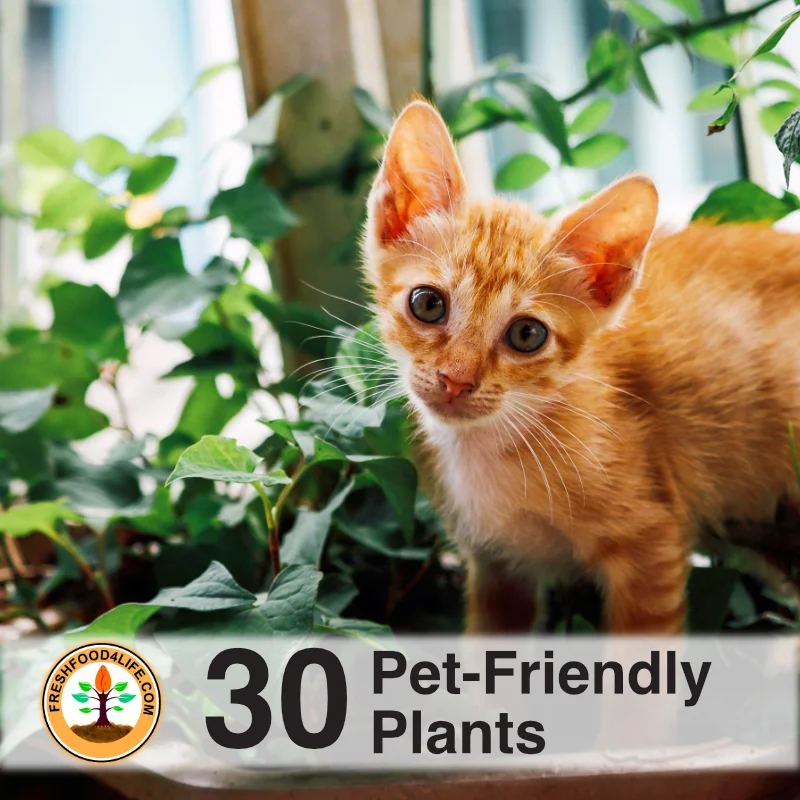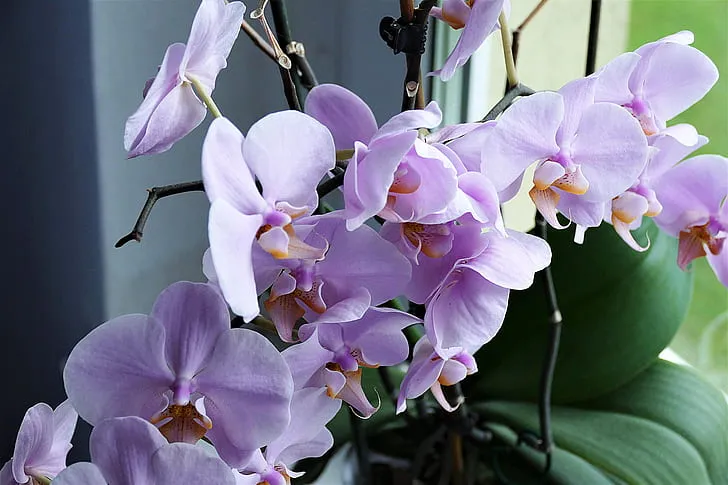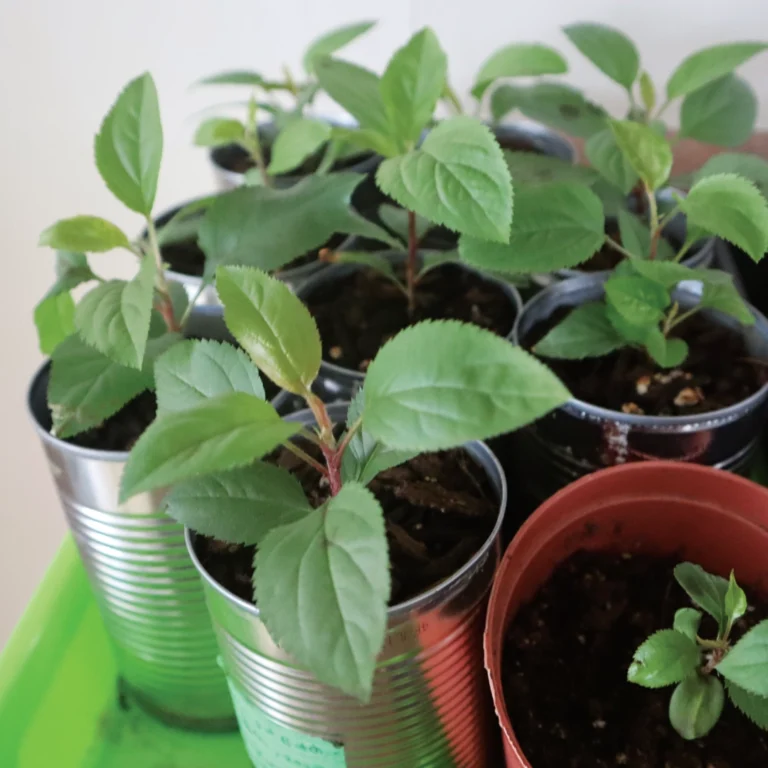Published: December 23, 2024 Last Updated: December 30, 2024

Love plants but have a furry friend? 🌿🐾
Bringing a bit of nature indoors can transform your home into a beautiful space. However, if you share your space with curious cats or playful pups, it’s essential to choose household plants that are safe for them.
In this post, we’ll explore a variety of pet-friendly plants that will add a touch of green to your home without posing any risk to your furry companions. From low-maintenance succulents to vibrant foliage plants, there’s something for everyone. Let’s dive in!
Table of Contents
Household Plants Safe For Cats And Dogs
1) Venus Flytrap

The first pet-friendly plant is the Venus flytrap (Dionaea muscipula). They are carnivorous plants native to the bogs of the Carolinas in the United States. They are famous for their unique trapping mechanism, consisting of modified leaves with sensitive trigger hairs. When an insect or other small creature brushes against these hairs, the trap snaps shut in a fraction of a second, imprisoning the prey. The plant then secretes enzymes that digest the victim, providing the plant with essential nutrients to continue to live.
Each trap can only open and close approximately 7-10 times before it stops working. Don’t cut off the leaves, but leave them to continue to harvest energy from the light. In time, more venus flytraps will grow.
2) Boston Fern

The second household plant safe for cats and dogs is the Boston fern, a.k.a. Sword Fern (Nephrolepis exaltata ‘Bostoniensis’). It is a popular houseplant known for its lush, arching fronds and air-purifying qualities. This fern was discovered in a large shipment of ferns sent from Philadelphia to Boston in 1894. (Read more about it)
This plant is very popular as an air purifier. Its delicate, finely divided fronds give it a soft, feathery appearance, making it an attractive addition to indoor spaces. Boston ferns thrive in humid environments with indirect light, mimicking their natural habitat in tropical and subtropical regions. They are relatively easy to care for but require consistent moisture, bright indirect sunlight and high humidity.
3) Money Tree

The third pet-friendly plant is the Money tree. The Money tree, a.k.a. Guiana chestnuts (Pachira aquatica) is a popular houseplant believed to bring good luck and financial prosperity. Native to Central and South America, it’s characterized by its braided trunk and palmate leaves. People often braid several young trees together as they grow; as they mature, these fuse to create the desired look.
In its natural habitat, the money tree can grow quite large, but when cultivated indoors, it typically remains a manageable size. It prefers bright, indirect light and well-draining soil, and it’s important to avoid over-watering, which can lead to root rot, so it should be very easy to take care of it. While it produces edible nuts in the wild, it rarely produces flowers or fruits indoors.
4) Spider Plant

The spider plant (Chlorophytum comosum) is a popular and easy-to-care-for houseplant known for its air-purifying abilities and distinctive appearance. It features long, slender green leaves that arch outwards, resembling spider legs. The plant also produces “spiderettes” or “pups” on long stems, which dangle down, creating a cascading effect. Native to South Africa, the spider plant thrives in bright, indirect light and well-draining soil. This plant can handle inconsistent watering because they have thick roots that can hold water. (Read more about it)
5) Rattlesnake Plant

The rattlesnake plant (Calathea lancifolia) is a striking houseplant prized for its patterned foliage. Native to Brazil, it has elongated, sword-like leaves with alternating dark green markings and a purple underside. This distinctive pattern resembles the markings on a rattlesnake’s skin, hence its common name.
The rattlesnake plant, like other Calathea family members, is famous for its “prayer plant” tendencies; its leaves fold upward at night and downward during the day in response to light. It thrives in warm, humid environments with indirect light, mimicking its natural rainforest habitat. Direct sunlight can scorch its delicate leaves and cause it to fade. Consistent moisture is crucial, but over-watering should be avoided.
6) Chinese Money Plant

The sixth pet-friendly plant is Chinese money plant, a.k.a. pancake plant (Pilea peperomioides). It is a popular houseplant prized for its unique, coin-shaped leaves. Native to the Yunnan province of southern China, it features round, bright green leaves that grow on long, and slender stems. It’s relatively easy to care for. It requires bright, indirect light and well-draining soil. Avoid over-watering to prevent root rot. New Chinese money plants are easily created by propagating the offshoots, or “pups,” which the plant readily produces.
7) Staghorn Fern

The staghorn fern (Platycerium) is an epiphytic fern (grows on another living plant for support), known for its unique, antler-like fronds. Native to tropical and subtropical regions around the world, it naturally grows on trees, absorbing moisture and nutrients from the air and surrounding debris. It features two types of leaves: basal leaves, which are broad and shield-like, and fertile leaves, which are forked and resemble deer antlers.
The basal leaves protect the plant’s roots and help it attach to its host. People commonly mount staghorn ferns on plaques or grow them in hanging baskets to mimic their natural growth habit. They prefer bright, indirect light and high humidity. Their striking appearance makes them a popular choice for adding a touch of the tropics to indoor spaces.
8) Nerve Plant

The Nerve Plant a.k.a. Mosaic Plant (Fittonia albivenis), is a captivating houseplant prized for its intricately veined leaves. Native to the rainforests of South America, it features vibrant green leaves interlaced with a network of contrasting veins, typically in shades of white, pink, red, or green. This striking pattern gives it its common name, as the veins resemble a network of nerves.
Nerve plants thrive in warm, humid environments with indirect light, replicating their native tropical habitat. Consistent moisture is important, but over-watering should be avoided. Their vibrant colors and intricate patterns make them a popular choice for adding a touch of color and texture to indoor spaces, often used in terrariums.
9) Parlor Palm

The ninth pet-friendly plant is the Parlor Palm (Chamaedorea elegans). It is a classic houseplant prized for its elegant, feathery fronds and air-purifying qualities. Native to the rainforests of Mexico and Guatemala, its popularity dates back to the Victorian era, where it was a common fixture in parlors, and was a symbol of wealth and prosperity.
The parlor palm is a relatively slow-growing plant. It prefers well-draining soil and moderate watering, allowing the soil to dry slightly between waterings. It’s also important to avoid over-watering, which can lead to root rot. This parlor palm is a perfect houseplant, because of its ability to thrive in low light conditions and requires little maintenance, so it’s a perfect plant to put on a north facing window.
10) Ponytail Palm

The Ponytail Palm a.k.a. Elephant Foot Tree (Beaucarnea recurvata) is a unique and low-maintenance houseplant, despite its name, it’s not actually a palm but a succulent. Native to southeastern Mexico, it’s characterized by its swollen, bulbous base, which stores water, and its long, slender, cascading leaves that resemble a ponytail. This succulent is well-adapted to dry conditions and prefers bright, indirect light.
It’s important to avoid over-watering, as this can lead to root rot. Allowing the soil to dry out completely between waterings is crucial for its health. Its distinctive appearance and easy-care nature make it a popular choice for plant enthusiasts seeking a drought-tolerant and visually interesting houseplant.
11) Orchid

Orchids are a diverse and fascinating family of flowering plants, known for their intricate and often exotic blooms. With tens of thousands of species found worldwide, they exhibit a remarkable variety of shapes, sizes, and colours. Many orchids are epiphytes, growing on other plants for support but not deriving nutrients from them. Their complex flowers typically feature specialized structures, such as the labellum (lip), which attracts pollinators.
Orchids have developed intricate relationships with specific insects, birds, or other animals for pollination. Growing and taking care of orchids can be a challenging task, as different species have varying needs for light, temperature, and humidity. However, their stunning beauty and long-lasting blooms that last 6-10 weeks make them a popular choice for plant enthusiasts.
12) Bamboo

While often envisioned as tall outdoor plants, Bamboo can thrive as a houseplant with proper care. You can get “lucky bamboo” (Dracaena sanderiana) which isn’t a true bamboo but looks like bamboo. It’s a popular, low-maintenance option easily grown in water or soil. You can also cultivate true bamboo species indoors, such as dwarf varieties of Pleioblastus or Bambusa, although they need more care.
Key requirements include bright, indirect light, consistent moisture without water-logging and soil that’s high in organic matter and humus rich. Regular fertilization during the growing season is beneficial.
13) Friendship Plant

The thirteenth pet-friendly plant is the Friendship Plant (Pilea involucrata). It is native to South and Central America. It’s important to remember that this plant is frequently mistaken for the Moon Valley Plant (Pilea mollis), another plant also known as a Friendship Plant. They look nearly the same, except the Friendship Plant has dark purplish veins while the moon valley plant has no veins. Although, they are both safe for pets.
The Friendship Plant requires bright indirect light, consistent watering and fertile to soil to grow in. Humidity is key for its survival since they are native to the tropics. You’ll want to keep this plant next to a small body of water or near a humidifier. Overall, this plant will add the beauty and texture to your home.
14) Haworthia

Haworthias is a small group of succulent plants native to South Africa. They’re prized for their unique and varied foliage. Often mistaken for miniature aloes or agaves, they belong to the Asphodelaceae family. Their leaves, which can be green, brown, or even reddish, are typically thick and fleshy, often featuring translucent “windows” or markings that allow light to reach the plant’s interior for photosynthesis. These markings can appear as stripes, dots, or intricate patterns.
Haworthias are relatively easy to care for, preferring bright, indirect light and well-draining soil. They are drought-tolerant and susceptible to root rot if over watered. Their compact size and low maintenance requirements make them popular choices for terrariums, dish gardens, and windowsill collections, appealing to both novice and experienced plant enthusiasts.
15) Echeveria

The fifteenth pet-friendly plant is Echeverias. They are another popular, succulent plant known for their rosette-shaped growth habit and diverse range of colors. Native to semi-desert regions of Central America, Mexico, and northwestern South America, they belong to the Crassulaceae family. Their fleshy leaves, which can be green, pink, purple, red, often resemble flowers.
Beside them looking like flowers, they also produce stunning flowers in the summer months. Echeverias are relatively easy to care for, thriving in bright, indirect light and well-draining soil. They are drought-tolerant and susceptible to root rot if over watered, making infrequent watering essential. Their attractive appearance and low maintenance requirements make them popular choices for container gardens and indoor displays, adding a touch of vibrant color and texture to any space.
16) Prayer Plant

The sixteenth household plant safe for cats and dogs is the Prayer Plant (Maranta leuconeura). Native to the tropical forest of Brazil, they’re best known for folding their leaves upwards at night, resembling hands in prayer, and then lower them during the day. The Prayer Plant is easy to take care. They require bright, indirect light, and well draining, loamy, acidic soil. You’ll want to water the plant once the top layer of the soil dries out, because they are susceptible to drought and won’t survive long if they don’t get water.
17) Herbs

They are a ton of herbs you can grow indoors that are pet-friendly. To name a few, basil, thyme, rosemary and dill. Herbs that are toxic to pets are oregano, garlicgarlic Garlic: An onion-like plant (Allium sativum) of southern Europe having a bulb that breaks up into separable cloves with a strong distinctive odor and flavor. Used as a seasoning in a variety of dishes around with world., onion, and lavender. Herbs are great to grow on a south-facing windowsill because they can thrive in low light conditions. In addition, the herbs will be fresh and close by when you need them for cooking.
18) Banana Tree

If you want to bring the tropical feeling indoors, then the banana tree is a must. You can get many indoor banana trees. Some of them are ornamental and some are fruiting varieties (although it’s unlikely they will fruit because they’re grown indoors). When getting a banana tree, you want to make sure it’s a dwarf.
These plants crave bright, indirect light, mimicking their natural habitat. Consistent moisture is key, but avoid over-watering to prevent root rot. Well-draining soil and a pot with drainage holes are essential. High humidity is also beneficial, so regular misting or a humidifier can help. With proper care, an indoor banana tree can bring a touch of the exotic to any home, adding a vibrant feel.
19) African Violet

The nineteenth household plant safe for cats and dogs is the African Violets (Saintpaulia ionantha). They are popular houseplants prized for their velvety leaves and vibrant, colorful blooms. Native to the tropical rainforests of Tanzania and Kenya. They prefer bright, indirect light, avoiding direct sunlight which can scorch their sensitive leaves. Consistent moisture is essential, but it’s crucial to water from the bottom to prevent water from sitting on the leaves, which can cause a lot of diseases. Well-draining soil and a pot with drainage holes are also important.
African violets prefer warm temperatures and moderate humidity. Removing spent blooms encourages further flowering. With their continuous blooming and compact size, African violets are a delightful addition to any indoor space, bringing a touch of color and elegance.
20) Bromeliad

Bromeliads are a diverse family of tropical plants known for their striking foliage and unique flower structures. Many are epiphytic, (growing on other plants for support), but not all are. A central “cup” or “tank” formed by their overlapping leaves, which collect water, characterizes them. This cup should always have some water at all times, because in the rainforests where they naturally grow, they always have water. Bromeliads prefer bright, indirect light and well-draining potting mix. Their vibrant colours make them popular houseplants, adding a touch of the tropics to indoor spaces.
21) Baby Rubber Plant

The twenty-first household plant safe for cats and dogs is the Baby Rubber Plant (Peperomia obtusifolia). It is a popular houseplant prized for its thick, glossy, and succulent-like leaves. Unlike its name suggests, it is unrelated to the Rubber Tree (Ficus elastica), which produces rubber. Its compact growth habit and easy care make it a superb choice for beginners.
The Baby Rubber Plant prefers bright, indirect light, avoiding direct sunlight which can scorch its leaves. It is relatively drought tolerant, so it’s important to avoid over-watering, allowing the soil to dry out between waterings. Well-draining soil is essential for preventing root rot. With its low-maintenance nature and attractive foliage, the Baby Rubber Plant is a charming addition to any indoor space, adding a touch of green without demanding constant attention.
22) Round Leaf Prayer Plant

The next pet-friendly plant is the Round Leaf Prayer Plant (Calathea orbifolia). It is a highly sought-after houseplant known for its large, rounded leaves featuring striking silvery-green stripes against a darker green background. This dramatic foliage makes it a standout in any indoor space. These plants need plenty of attention to survive.
Native to tropical rainforests, it thrives in warm, humid conditions and prefers bright, indirect light. Direct sunlight can easily scorch its delicate leaves. Consistent moisture is crucial for its health, but it’s important to avoid soggy roots, which can lead to root rot. With proper care, the Round Leaf Prayer Plant adds a touch of tropical elegance to any home.
23) Bird’s Nest Fern

The twenty-third household plant safe for cats and dogs is the Bird’s Nest Fern (Asplenium nidus). It is a unique and visually striking fern characterized by its upright, vase-like growth habit. The bright green fronds are broad, simple, and have a slightly wavy or crinkled texture, resembling a bird’s nest in the center where new fronds emerge.
Native to tropical rainforests of Asia, Australia, and East Africa, it thrives in warm, humid conditions and prefers bright, indirect light, with partial shade. It’s important to avoid watering the central “nest” directly, as this can lead to mold growth and rot. Instead, water around the base of the plant, allowing it to dry the soil out half way between waterings.
24) Polka Dot Plant

The next pet-friendly plant is the Polka Dot Plant (Hypoestes phyllostachya). It is a vibrant and eye-catching houseplant known for its brightly speckled foliage. Its leaves are typically green with splashes of pink, red, white, or even purple, creating a “polka dot” effect.
Polka Dot Plants are relatively easy to care for, thriving in bright, indirect light. They prefer consistently moist soil but not soggy conditions, so good drainage is essential. Although they can produce small flowers, people primarily grow them for their colorful and cheerful foliage, which adds a splash of personality to any indoor space. The plant is short term as it has a short lifespan, about 1-2 years.
25) Baby Tears
.jpg)
Baby Tears Plant a.k.a. Angel’s Tears (Soleirolia soleirolii) is a tropical, creeping perennial with clusters of miniature leaves. This plant is from the nettle family, and native to islands in the western Mediterranean and parts of Italy. They require low-light conditions, a warm climate and rich, moist soil to thrive. Don’t let the roots sit in water, which can promote root rot. In late spring, the plant will produce tiny, creamy white flowers.
26) Sensitive Plant

The Sensitive Plant a.k.a. Shy Plant (Mimosa pudica) is a creeping shrub known for its purplish-pink, pompom flowers. Tiny hairs lining the plant’s leaves respond to touch, temperature, and motion, folding inwards when triggered. Sensitive plant grows best in full sunlight, and well-draining, acidic soil. Keep the soil consistently moist but not soggy. You can watch a video of the leaves closing when touched here.
27) Watermelon Peperomia

The next pet-friendly plant is the Watermelon Peperomia (Pilea argyreia). This plant has exploded in popularity because of its watermelon looking foliage. Native to South America, these plants are tropical. Watermelon Peperomia are easy to care for, they require bright, indirect light, and well-draining soil. They are sensitive to over-watering and under-watering so consistent moisture is key. Its unique foliage and relatively low-maintenance nature make it a delightful addition to any houseplant collection.
28) Air Plant

As its name means, the Air Plant thrives without soil and nutrients. Native to the areas of Southern U.S., Mexico, and South America. This plant grows on other plants in nature, usually branches of trees. They have narrow leaves and are very easy to care for. You want to keep the plants out of direct sunlight.
The Air Plants don’t have roots like other plants, but that doesn’t mean they need water. The best way to water these plants is to submerge them in water for 30-60 minutes. Then put them on a cloth to dry for an hour or two. Do this once a week. Because this plant requires little effort, you can hang them from ceilings to create a bit of nature in your home.
29) Burro’s Tail

The next pet-friendly plant is the Burro’s Tail a.k.a Donkey’s tail (Sedum morganianum). It is a succulent, and just like the rest of them, they thrive on a little neglect. They require a little water. Place them in a bright, low-traffic spot because the pointed small leaves are extremely fragile and can break off with the slightest touch. It’s best to grow in a hanging container because they will sprawl out.
30) Majesty Palm

People grow the Majesty Palm (Ravenea rivularis) mostly as an air-purifying tree. This plant will grow up to 10 feet tall in a confined pot. Native to Madagascar, it thrives in consistently moist conditions, unlike many other palms that prefer drier environments. It prefers bright, indirect light, though it can tolerate some shade. Majesty palms also appreciate high humidity, so regular misting or a humidifier can be beneficial, especially in drier climates. With its graceful presence and relatively easy care, the majesty palm brings a touch of tropical majesty to any home.
Final Thoughts
Creating an environment for your cuddly friends doesn’t mean sacrificing your love for indoor greenery. With a wide variety of non-toxic options available, you can cultivate a thriving indoor jungle while ensuring the safety of your furry companions. From the elegant majesty palm to the vibrant polka dot plant and the unique watermelon peperomia, there’s a plant to suit every taste and style.
Remember to always double-check plant identification and monitor your pets for any unusual reactions, even with non-toxic varieties. By choosing wisely and providing proper care, you can enjoy the beauty and benefits of houseplants without compromising your pets’ well-being. If you decide to get any of these plants at your local nursery, please let them know about us!




